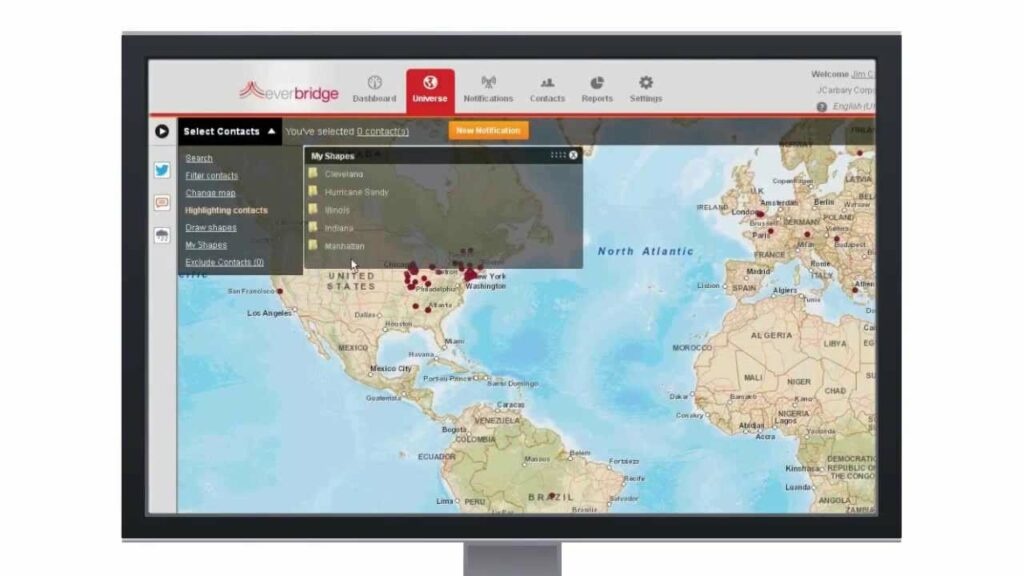A facilitated discussion with leaders about communicating emergency information to employees and key stakeholders
Physical security information management (PSIM) is a category of software that is designed to integrate multiple unconnected security applications, enable automation of workflows and processes, and provide control over devices through a unified user experience.
It can operate as a platform dedicated for physical security or as part of a broader Critical Event Management (CEM) capability.
Find out How We Deliver PSIM with Control Center.
PSIM Quick Assessment: Interested in understanding how PSIM can benefit your organization? Take our quick assessment to find out more.
How PSIM transforms security operations
It collects and correlates events from existing disparate security systems and information systems (video, access control, sensors, analytics, networks, building systems, cyber, etc.) to empower personnel to accurately identify and proactively resolve situations.
Why your organization needs PSIM
PSIM enables numerous organizational benefits, including increased control, improved situational awareness, and management reporting. Ultimately, these solutions allow organizations to reduce costs through improved efficiency and to improve their security posture with increased intelligence and compliance.
Key features of a comprehensive PSIM platform
A complete PSIM software system provides six key capabilities that help to distinguish it from other forms of physical security management:
- Integration: A PSIM provides an open architecture to integrate data from any number of disparate security devices or systems, regardless of vendor.
- Analysis: A PSIM provides a workflow engine that analyzes and correlates the data, events, and alerts to identify the real situations and their priority.
- Verification: A PSIM presents the relevant situation information and standard operating procedures (SOPs), based on an organization’s policies.
- Resolution: A PSIM supports device actuation and control to allow users to take action and resolve situations without switching to other software systems.
- Reporting: PSIM software structures the data from the integrated systems to provide a single source of truth for compliance, reporting, and training.
- Auditing: A PSIM also tracks all the information received and captures operator interactions as well as system changes for in-depth investigative analysis.
What PSIM does
Beyond the timesaving and efficiency benefits, PSIM also provides risk reduction through automation and ensuring compliance to policies, accelerated response times, accurate cross-system reporting, and avoiding technology lock-ins.
PSIM enables business processes that are essential to any modern security department such as continuous process improvement initiatives, training drills, system healthcare checks, and much more.
PSIM Quick Assessment: Interested in understanding how PSIM can benefit your organization? Take our quick assessment to find out more.
How PSIM enhances threat verification
Many of the alerts that come into the security environment are not really threats. These need to be prioritized according to risk and relevance, such as time of day, location of personnel, and a whole range of other critical factors. ‘Dynamic alarm management’ is required to find the ‘hot’ ones which indicate that some action may need to be taken. Connected systems and automation of processes such as key personnel alerting, video verification, and Service Level Agreements (SLA) will help to enable situational awareness and ensure alerts are followed up quickly and best-informed decisions are taken.

The benefits of unifying security with PSIM
PSIM is enabling organizations such as yours to establish a converged and unified security posture. Some of the advantages this provides include:
- Complete situational awareness across all aspects of security.
- Consistent levels of security across all locations (no weak links).
- Cost reductions by making manned guarding more efficient.
- Cost reductions by reducing control rooms and floorspace requirements.
- Enabling remote monitoring with distributed command and control.
- Automated reports and dashboards covering the entire security estate.
- Web clients that allow coordination and management outside the control room.

Maximizing your ROI with PSIM
Today’s security operations need to leverage the power of automation to make fast, accurate decisions, based on specific organizational policies and procedures. Many security operations have grown over the years with the incremental introduction of point solutions.
From a strategic perspective, leading organizations are focusing on growing their security posture to provide superior operational resilience, rather than trying to simply decrease security costs. Safety and security are no longer about guards, gates, observation, and reaction but about automation, analytics, and proactive control.
PSIM has become the perfect catalyst for this transition from point solutions which are reliant on constant monitoring and input by security personnel, to an information-driven platform that proactively manages the increasing volume of information in the control room.
PSIM in action: Industries and key roles
PSIM (Physical Security Information Management) is used by a diverse range of organizations that require integrated and efficient security systems. Key users include security directors, IT managers, facility managers, compliance officers, and operations managers across various industries. Key sectors include:
- Corporations and enterprises: Large organizations with extensive physical assets and personnel rely on PSIM for centralized security management across multiple locations.
- Transportation hubs: Airports, seaports, and railway stations use PSIM to manage and monitor security systems, ensuring safe and efficient operations.
- Government and public sector: Agencies and departments use PSIM to enhance security and operational efficiency in public safety, transportation, and critical infrastructure.
- Utilities and critical infrastructure: Providers of essential services such as energy, water, and telecommunications use PSIM to protect their facilities from physical and cyber threats.
- Healthcare facilities: Hospitals and healthcare systems implement PSIM to ensure the safety of patients, staff, and visitors, as well as to comply with regulatory requirements.
- Pharmaceutical companies: Pharmaceutical firms use PSIM to safeguard sensitive research and development operations, protect intellectual property, and ensure regulatory compliance.
- Financial services: Banks, insurance companies, and other financial institutions utilize PSIM to comply with stringent regulations, protect sensitive financial data, and prevent fraud.
- Educational institutions: Universities and schools adopt PSIM to maintain campus security and integrate various security systems for a unified response.
- Retail and hospitality: Retail chains and hotel groups employ PSIM to safeguard their properties, reduce theft, and enhance customer safety.
Additionally, PSIM is also used by many other sectors including manufacturing, logistics, entertainment venues, and more, where comprehensive security management is essential. These organizations leverage PSIM to achieve comprehensive situational awareness, streamline security operations, and ensure compliance with industry standards and regulations.
Ready to implement PSIM? Take our quick assessment
Interested in understanding how PSIM can benefit your organization? Take our quick assessment to find out more.
Making an informed decision: Download the PSIM buyer’s guide
Ready to take the next step? Download our comprehensive PSIM Buyers Guide (link) with 15 essential questions to help you make an informed decision.
We help armed forces achieve their integrated base defense goals, at home and around the world: simplifying integration, increasing situational awareness and promoting quicker responses. Prepare for a better tomorrow with a futureproof platform that can do so much more for armed forces applications.
Hear from a handful of Everbridge leaders and our customers about what it is we do and what the best parts about our platform are.
On June 24, 2013, Everbridge announced the release of the Everbridge solutions suite, the first single system for enterprise critical communications. In this product release video, CEO Jaime Ellertson, CTO Imad Mouline, and VP of Product Management Claudia Dent explain and introduce the new benefits and features of the new Everbridge solutions suite, such as Everbridge’s Next Generation Incident Management, best in class enterprise capabilities, mobility enhancements, secure messaging, IPAWS/WEA, and Hail & Lightning Alerts.

